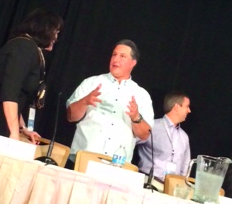I have a bit of spare time at a busy conference at share 14 – so I thought I would stop in on this session, involving Bing, Facebook and Twitter amongst the speakers. Since I am here, it seems rude not to share their secrets!
Duane is Bing’s search evangelist. He started by saying that Social these days is ALMOST as important as content.
Duane moved quickly into links. That’s where I thought we should pick up his presentation. He said that Links are still important, but he asked the question “How many links does it tale to rank”? I answered, saying “one”. Duane’s a friend and told me that my vote doesn’t count… but then he agreed.
It’s Quality, not quantity, when it comes to links!
Duane said that all the people re-tweeting, talking about and a piece of content are all very strong signals that the content is quality. These signals help to confirm the content is valuable.
What he didn’t say is that talking about a piece of content on Twitter is the same as linking to a piece of content.
Majestic also would agree that you may only need one link. We can also say the likelihood that one link is enough, through our Trust Flow calculation.
Duane went further into talking about the impact that Social has on search, by looking at the rich universal results that Bing uses. He also explained how the serps might change on the fly, depending on what the the is doing, where they are and even the time of day. He gave the the example of a search for “Subway”. He said that if you have a meeting in an hour half way across town, Bing can tell that you are more likely to want an underground train than some food.
Rob Creekmore (Facebook)
Rob works on the advertising team at Facebook. He spent several years at Amazon previously, looking at analyzing data, so he should know what he is talking about. He said that focusing solely on Search is a mistake, because of the way users now travel down the sales funnel these days. Search is only PART of the journey, so you are unlikely to get much traction with search alone. Users take their signals from multiple sources before they buy or become a brand advocate and (surprise, surprise) Rob used some research from Kenshoo to show the lift of combining Facebook and Search advertising at the same time. They found a 30% increase in return on adspend when you add Facebook into the mix.
When they analyzed this further, to work out why this was the case, one of the main reasons was that the increase in trust meant that users spent considerably more when they were also touched by the Facebook advertising.
They also found through separate research through Experian a 19 % lift in search-attributed conversion when Facebook was also involved in the mix.
David Whitworth (Rackspace)
Rackspace is a huge ISP and has cloud based webserver offerings. He started with the mantra that “Good content is no longer good enough”. He’s right! He used an analogy similar to one I used last year around feeding a plant from the roots. He also said that we need to focus on content that “earns links” not “creates links”. That’s a really powerful statement and worthy of pause for thought. Earning a link means that you link to something only because you feel it will add to your own narrative.
Brenna Comacchio (Autodesk)
Autodesk is a 3D design software – the guys that originally created AutoCad.
I was delighted to hear her case study about a campaign around a very specific keyword where they were not ranking. They campaign included link building, were they acquired 60 links. (I checked on Majestic and we are seeing 217, so either they have continued to grow since she measured, or she used another data source to get that number. They now rank number one for the phrase. The content they created also created significant social signals, as users tweeted the new content online.
Eddie Smith (Twitter)
Eddie was just answering Q&A. He was asked by Kristin Morse, the moderator, about the interaction between Twitter and search. He said that MUCH of the activity was revolved around links! Eddie, I love you. He talked about how users are using Twitter to analyse which messages are getting Tweets and retweets and clicks to help identify what content is working and then taking this insight into search.
There were huge subtleties that he recommended we all use when testing links in Tweets. One exclamation mark or two? Forming the Tweet as a question or as a statement? These should be part of your strategy. He also talked about Twitter cards. This is also something that Majestic has already integrated into it’s own digital marketing efforts.
- How Important will Backlinks be in 2023? - February 20, 2023
- What is in a Link? - October 25, 2022
- An Interview with… Ash Nallawalla - August 23, 2022








Nothing new there then! I’m not convinced that social is almost as convincing as content. Statistics can be used to show just about anything you want (read “How to Lie with Statistics” by Darrell Huff). In SEO, every market, every niche, the quality of content, types of keywords, audience etc are different for every single search term so there is no magic one size fits all formula I’m afraid!
August 26, 2014 at 3:26 pmEssentially it is about getting links from quality, authorative and relevant websites – and there are many ways to do that. Quality content doesn’t always cut it – there are many markets and products which just will not get enough links naturally because they are not interesting.
I’ve waffled on long enough. Reading through it, how on earth am I going to produce the famous “compelling content” that will earn me links because everyone will want to link to it?